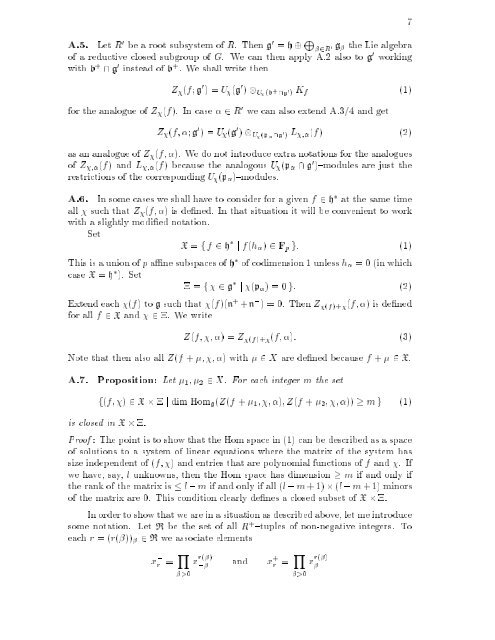subregular nilpotent representations of lie algebras in prime ...
subregular nilpotent representations of lie algebras in prime ...
subregular nilpotent representations of lie algebras in prime ...
You also want an ePaper? Increase the reach of your titles
YUMPU automatically turns print PDFs into web optimized ePapers that Google loves.
A.5. Let R 0 be a root subsystem <strong>of</strong> R. Then g 0 = h L 2R 0 g the Lie algebra<br />
<strong>of</strong> a reductive closed subgroup <strong>of</strong> G. We can then apply A.2 also to g 0 work<strong>in</strong>g<br />
with b + \ g 0 <strong>in</strong>stead <strong>of</strong> b + .We shall write then<br />
Z (f; g 0 )=U (g 0 ) U (b + \g 0 ) Kf (1)<br />
for the analogue <strong>of</strong> Z (f). In case 2 R 0 we can also extend A.3/4 and get<br />
Z (f; ; g 0 )=U (g 0 ) U (p \g 0 ) L ; (f) (2)<br />
as an analogue <strong>of</strong> Z (f; ). We do not <strong>in</strong>troduce extra notations for the analogues<br />
<strong>of</strong> Z ; (f) and L ; (f) because the analogous U (p \ g 0 ){modules are just the<br />
restrictions <strong>of</strong> the correspond<strong>in</strong>g U (p ){modules.<br />
A.6. In some cases we shall have to consider for a given f 2 h at the same time<br />
all such that Z (f; ) is de ned. In that situation it will be convenient towork<br />
with a slightly modi ed notation.<br />
Set<br />
X = f f 2 h j f(h ) 2 Fp g: (1)<br />
This is a union <strong>of</strong> p a ne subspaces <strong>of</strong> h <strong>of</strong> codimension 1 unless h =0(<strong>in</strong>which<br />
case X = h ). Set<br />
=f 2 g j (p )=0g: (2)<br />
Extend each (f) tog such that (f)(n + +n , ) = 0. Then Z (f)+ (f; ) is de ned<br />
for all f 2 X and 2 . We write<br />
Z(f; ; )=Z (f)+ (f; ): (3)<br />
Note that then also all Z(f + ; ; )with 2 X are de ned because f + 2 X.<br />
A.7. Proposition: Let 1; 2 2 X. For each <strong>in</strong>teger m the set<br />
f(f; ) 2 X j dim Homg(Z(f + 1; ; );Z(f + 2; ; )) m g (1)<br />
is closed <strong>in</strong>X .<br />
Pro<strong>of</strong> : The po<strong>in</strong>t istoshow that the Hom space <strong>in</strong> (1) can be described as a space<br />
<strong>of</strong> solutions to a system <strong>of</strong> l<strong>in</strong>ear equations where the matrix <strong>of</strong> the system has<br />
size <strong>in</strong>dependent <strong>of</strong>(f; ) and entries that are polynomial functions <strong>of</strong> f and .If<br />
we have, say, l unknowns, then the Hom space has dimension m if and only if<br />
the rank <strong>of</strong> the matrix is l , m if and only if all (l , m +1) (l , m + 1) m<strong>in</strong>ors<br />
<strong>of</strong> the matrix are 0. This condition clearly de nes a closed subset <strong>of</strong> X .<br />
In order to show that we are <strong>in</strong> a situation as described above,letme<strong>in</strong>troduce<br />
some notation. Let R be the set <strong>of</strong> all R + {tuples <strong>of</strong> non-negative <strong>in</strong>tegers. To<br />
each r =(r( )) 2 R we associate elements<br />
x ,<br />
r<br />
= Y<br />
>0<br />
r(<br />
x, )<br />
and x + Y r(<br />
r = x<br />
>0<br />
)<br />
7

















